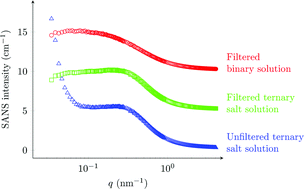Mesoscale phenomena in solutions of 3-methylpyridine, heavy water, and an antagonistic salt
Abstract
We have investigated controversial issues regarding the mesoscale behavior of

Maintenance work is planned for Wednesday 1st May 2024 from 9:00am to 11:00am (BST).
During this time, the performance of our website may be affected - searches may run slowly and some pages may be temporarily unavailable. If this happens, please try refreshing your web browser or try waiting two to three minutes before trying again.
We apologise for any inconvenience this might cause and thank you for your patience.
* Corresponding authors
a
Institute for Physical Science and Technology, University of Maryland, College Park, MD 20742, USA
E-mail:
anisimov@umd.edu
Tel: +1-301-405-8049
b Laboratorium voor Akoestiek en Thermische Fysica, Departement Natuurkunde en Sterrenkunde, KU Leuven, 3001 Leuven, Belgium
c Department of Chemical and Biomolecular Engineering, University of Maryland, College Park, MD 20742, USA
d NIST Center for Neutron Research, National Institute of Standards and Technology, Gaithersburg, MD 20899, USA
We have investigated controversial issues regarding the mesoscale behavior of

 Please wait while we load your content...
Something went wrong. Try again?
Please wait while we load your content...
Something went wrong. Try again?
J. Leys, D. Subramanian, E. Rodezno, B. Hammouda and M. A. Anisimov, Soft Matter, 2013, 9, 9326 DOI: 10.1039/C3SM51662H
To request permission to reproduce material from this article, please go to the Copyright Clearance Center request page.
If you are an author contributing to an RSC publication, you do not need to request permission provided correct acknowledgement is given.
If you are the author of this article, you do not need to request permission to reproduce figures and diagrams provided correct acknowledgement is given. If you want to reproduce the whole article in a third-party publication (excluding your thesis/dissertation for which permission is not required) please go to the Copyright Clearance Center request page.
Read more about how to correctly acknowledge RSC content.
 Fetching data from CrossRef.
Fetching data from CrossRef.
This may take some time to load.
Loading related content
